If the probability of success is 5, ie, 5050 percent chance, then the odds of success is 1 to 1 The transformation from probability to odds is a monotonic transformation, meaning the odds increase as the probability increases or vice versa Probability ranges from 0 and 1 Odds range from 0 and positive infinity Odds, chances and probability are just different ways of expressing the likelihood of an event In your example of the jackpot that hits on average once per 100,000 spins, the probability of hitting the jackpot is Many people have difficulty relating to a decimal number So another, equivalent way to express the likelihood of hittingRISK AND ODDS DEFINITIONS "Risk" refers to the probability of occurrence of an event or outcome Statistically, risk = chance of the outcome of interest/all possible outcomes The term "odds" is often used instead of risk "Odds" refers to the probability of occurrence of an event/probability of the event not occurring

Biostatistics Weeks 10 11 Flashcards Quizlet
Are odds and probability the same
Are odds and probability the same-Using an example of decimal odds, a candidate has 2 odds to win the next election If so, the implied probability is 4545%, or ( 1 2 2 × 1 0 0) \begin {aligned} &\left ( \frac { 1 } { 22 What Is Probability Theory?




Estimates Of Odds Ratios Of Daily Probability Of Diarrhea In The Download Scientific Diagram
Labs(title ="probability versus odds") 000 025 050 075 100 0 50 100 150 odds p probability versus odds Finally, this is the plot that I think you'llfind most useful because inlogistic regression yourregression equation,eg,βˆ 0 βˆ 0 ·x 1 yieldsthelogodds,andyou'reinterestedinhowthatrelatestotheprobabilityof The wikipedia page claims that likelihood and probability are distinct concepts In nontechnical parlance, "likelihood" is usually a synonym for "probability," but in statistical usage there is a clear distinction in perspective the number that is the probability of some observed outcomes given a set of parameter values is regarded as the likelihood of the set of parameter Probability vs Odds vs Log Odds All these concepts essentially represent the same measure but in different ways In the case of logistic regression, log odds is used We will see the reason why log odds is preferred in logistic regression algorithm Probability of 0,5 means that there is an equal chance for the email to be spam or not spam
Odds The odds in favor of an event is the ratio of the number of ways the outcome can occur to the number of ways the outcome cannot occur # of ways the event CAN occur # of ways the event CANNOT occur This is actually a lot easier than probabilityOdds versus probability Odds versus probability Summary 1 Probability is ll possible outcomes The term "odds" is often used instead of Odds ratios work the same An odds ratio of 108 will give you an 8% increase in the odds at any value of X Likewise, the difference in the probability (or the odds) depends on the value of X So if you do decide to report the increase in probability at different values of X, you'll have to do it at low, medium, and high values of X
So a probability of 0 means there's literally no chance of that thing happening, a probability of 05 means there's a 50% chance, and a probability of 1 means that it's certain to happen As you can see, the idea of probability is relatively simple But the idea of odds, on the other hand, is a bit more complicatedmostly because there Odds Odds seems less intuitive It is the ratio of the probability a thing will happen over the probability it won't In the spades example, the probability of drawing a spade is 025 The probability of not drawing a spade is 1 025 So the odds is 025/075 or 13 (or 033 or 1/3 pronounced 1 to 3 odds) Moving back and forthIt is important to note, however, that odds to not directly represent probability of an event occurring, but rather the ratio of events to nonevents in total Odds vs Probability A good way to understand the difference between odds and probability is to imagine rolling a die and hoping to land on a two The odds of rolling the two are 1 to 5




Calculating The Odds Of An Event Mathematics For The Liberal Arts




Odds Ratios And Log Odds Ratios Clearly Explained Youtube
Of probability, chances and odds are not the same For instance, the odds in favor of A are P(A) / P(Ac) = (3/4)/(1/4) = 3/1 It is said that the odds in favor of A are 31 or that A is an event twice as likely as "not A" Therefore, the odds of A occurring are expressed in the scale of the probability of "A not occurring" To convert any probability under 50% to a fair money line, the formula is 100*(1p)/p, where p is the probability of winning To convert any probability over 50% to a fair money line, the formula is 100*p/(1p) Parlays Here is my quick advice on parlays Betting off the board, do not pick more than three teams or totals at 110 oddsFor converting odds to probability, we have to divide the odds by 1 odds For instance, let's convert odds of 1/9 to a probability Now, divide 1/9 by 10/9 to get the probability of 010 2 What are the odds
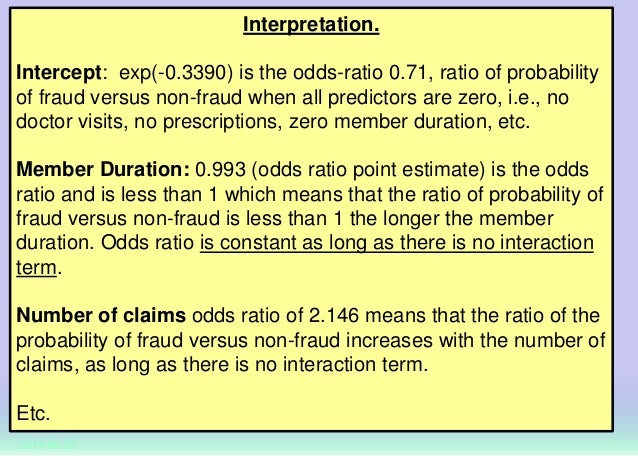



Classification Methods And Assessment
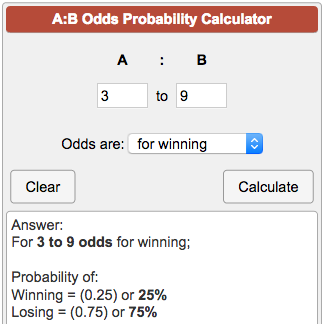



Odds Probability Calculator
Money Line Implied Probability The following chart shows how likely a team is to win based off the odds This is helpful in handicapping because you can see just what percentage of your wagers you need to win at each given money line in order to profit The left chart is to be used for favorites, the right for underdogs The probability that an event will occur is the fraction of times you expect to see that event in many trials Probabilities always range between 0 and 1 The odds are defined as the probability that the event will occur divided by the probability that the event will not occur A probability of 0 is the same as odds of 0In this matchup, there is a big difference between the two odds, indicating a much higher probability of Duke winning the game and advancing to the next round of the NCAA Tournament
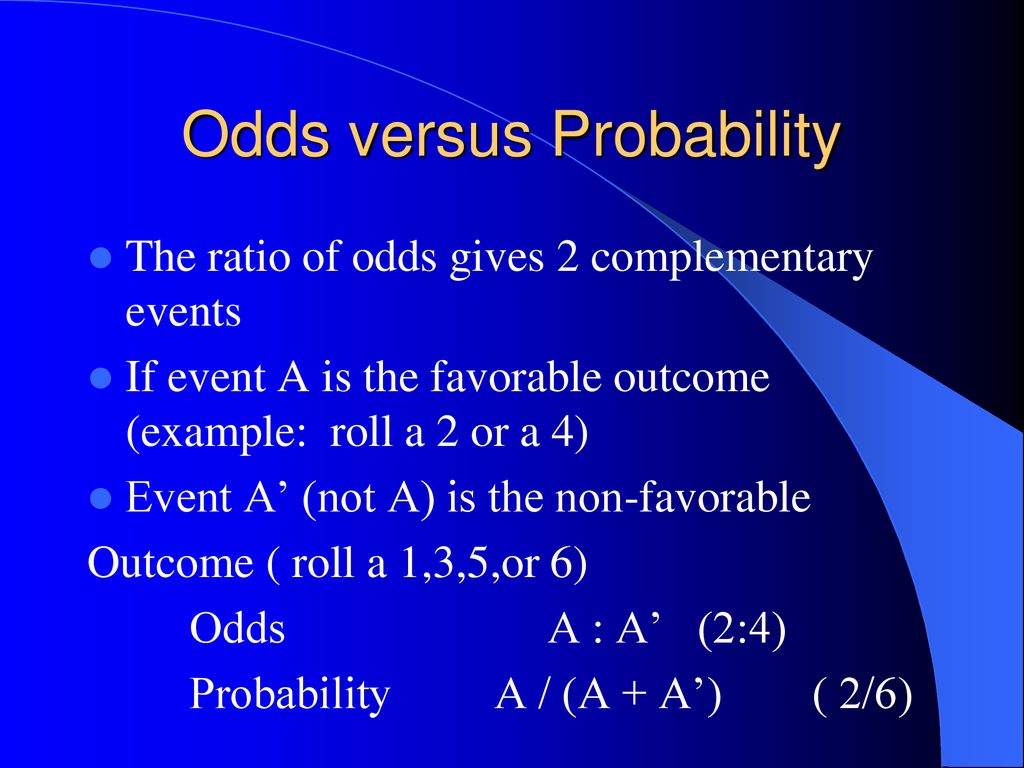



Odds Ppt Download




How To Read Odds 13 Steps With Pictures Wikihow
Odds is a see also of probability As nouns the difference between odds and probability is that odds is the ratio of the probabilities of an event happening to that of it not happening while probability is the state of being probable; Converting between odds and probability Converting Odds to Probability Simply add the 2 components of the odds together to make a new denominator, and use the old numerator eg If the odds are 35, or 3 to 5, the probability is 3 ÷ (35) = 3/8 = 375% Converting Probability to Odds Take the probability, and divide it by its compliment Odds provide a measure of the likelihood of a particular outcome They are calculated as the ratio of the number of events that produce that outcome to the number that do not Probability noun a measure of how likely it is that some event will occur;
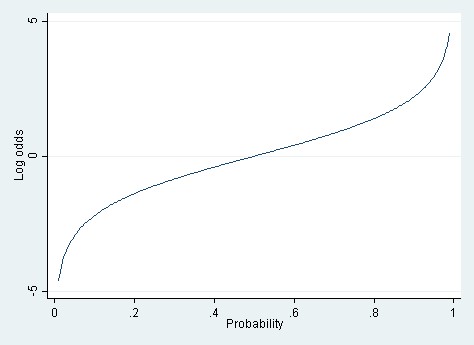



Linear Vs Logistic Probability Models Which Is Better And When Statistical Horizons




What Are The Odds Stats With Cats Blog
The terms probability and odds measure one's belief in the occurrence of a future event It may confuse since both 'Odds' and 'probability' are related to the potential that event occurs However, there is a difference Probability is a broader mathematical concept Summary 1 Probability is a mathematical measure of how often an event will occur;Pretest probability and posttest probability (alternatively spelled pretest and posttest probability) are the probabilities of the presence of a condition (such as a disease) before and after a diagnostic test, respectively Posttest probability, in turn, can be positive or negative, depending on whether the test falls out as a positive test or a negative test, respectively



Logistic Regression




Binary Logistic Regression With Odds Ratios Calculated For The Download Table
Odds vs Probability While odds and probability are related mathematical concepts, the two are also distinctly different The probability of something occurring represents the fraction of times you'd see it happen over several trials If you have a 50% probability of catching the bus, that number represents the idea that you will catch theOdds measure the chances for and the chances against an event ever occurring 3 Probability ensures that an event will occur; The odds are 1626 and probability is 016% If you're playing poker long enough you will somewhat regularly encounter the aces vs kings scenario at a table A formula to estimate the probability for this to happen at a 9 player table is This formula slightly underestimates the actual probability which is a little bit higher




Probability Vs Odds What S The Difference Learn It And By Z Ai Towards Data Science




How To Calculate Odds 11 Steps With Pictures Wikihow
Statistics — Probability vs Odds 📅 Probability and odds are two basic statistic terms to describe the likeliness that an event will occur They are often used interchangeably in causal conversation or even in published material However, they are not mathematically equivalent because they are looking at likeliness inThe odds of an event represent the ratio of the (probability that the event will occur) / (probability that the event will not occur) This could be expressed as follows Odds of event = Y / (1Y) So, in this example, if the probability of the event occurring = 080, then the odds are 080 / (1080) = 080/0 = 4 (ie, 4 to 1)Many people wrongfully assume odds and probabilities are the same thingThey're definitely not, as there's a significant difference between saying there are




Probability Vs Odds What S The Difference Learn It And By Z Ai Towards Data Science




Converting Probability To Odds Example Youtube
Odds can be helpful when we want to compare how much larger one probability is relative to another An event with a probability 75% has odds of 75 to 25 We can simplify this to 3 to 1 This means that the event is three times more likely to occur than not occur Cite this Article Odds ratio vs probability ratio Ask Question Asked 1 year, 7 months ago Active 6 months ago Viewed 602 times 8 5 $\begingroup$ An odds is the ratio of the probability of an event to its complement $$\text{odds}(X) = \frac{P(X)}{1P(X)}$$ An odds ratio (OR) isThe probability of having the winning plate is 1 out of 25 Odds of winning = number of chances to win number of chances to draw other numbers Odds of winning = 124 (Read as "1 to 24") Odds of not winning = number of chances to draw other numbers number of chances to win Odds of not winning = 241 (Read as "24 to 1")
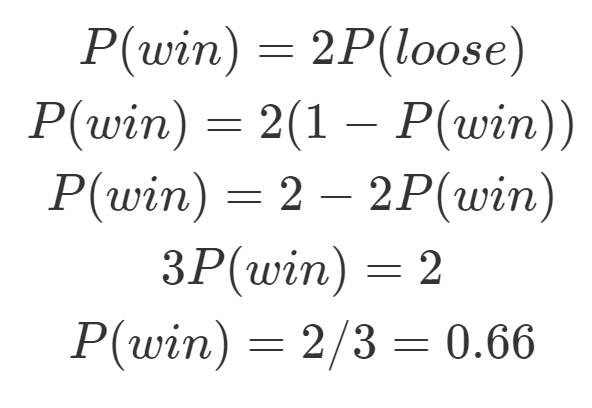



Probability Vs Odds What S The Difference Learn It And By Z Ai Towards Data Science




Definition And Calculation Of Odds Ratio Relative Risk Stomp On Step1
Odds are based on the probability that an event will ever occur 2 Probability only measures the chances that an event will occur against the total number of times the even will occur; FAQs on Odds Vs Probability 1 How do you convert odds to probability? The Ask Dr Math forum has several entries on odds versus probability Summarizing, one way to conceptualize (nontechnically) the probability of an event is the number of ways that an event can occur divided by the total number of possible outcomes The probability of heads in a fair coin flip is 1/2 (50 percent)




Ppt Main Points To Be Covered Powerpoint Presentation Free Download Id
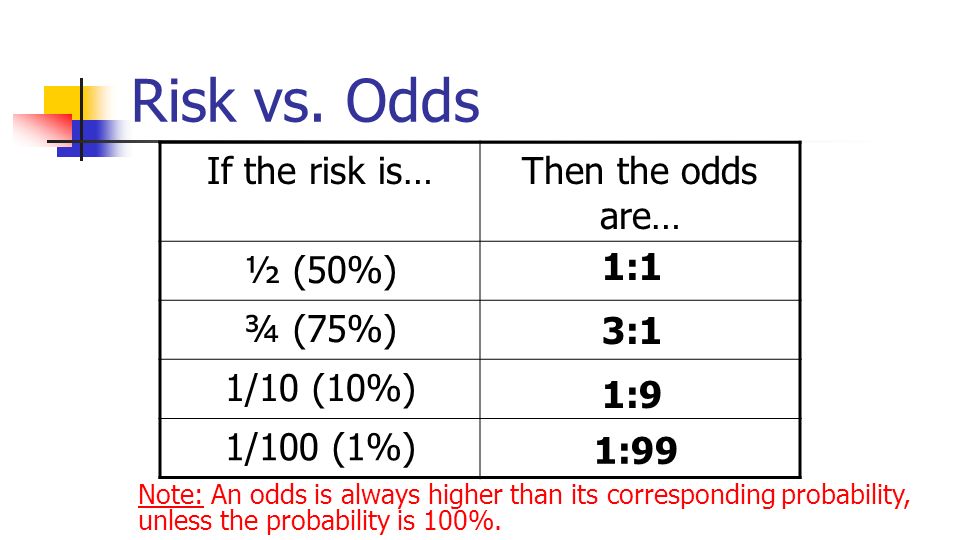



印刷可能 Odds Vs Risk ただの悪魔の画像
P / (1p) = exp (Xb) The language here is sometimes confusing because some authors call this the odds ratio Englishwise, they are correct it is the odds and the odds are based on a ratio calculation It is not , however, the odds ratio that is talked about when results are reportedHow to find probability and odds and the difference between the two We also discuss experimental probablility, theoretical probability, odds in favor, and Odds Is Related to Probability The formal way to describe the odds is as the probability of the event divided by the probability of the nonevent So odds are the ratio of two fractions the number of events divided by the number of
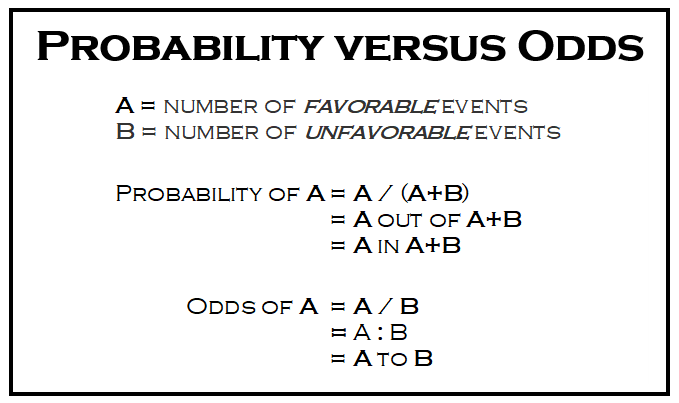



What Are The Odds Stats With Cats Blog



1
Once again, the calculation is slightly different for minus odds versus plus odds Implied Probability = (1*(Odds)) / (1(Odds) 100) Which looks likeProbability theory is an interesting area of statistics concerned with the odds or chances of an event happening in a trial, eg getting a six when a dice is thrown or drawing an ace of hearts from a pack of cards To work out odds, we also need to have an understanding of permutations and combinations Probability in Terms of Odds for and against the Event Odds for and against an event represent a ratio of the desired outcomes versus the field In other words, the odds for an event are the ratio of the number of ways the event can occur to the number of ways the event does not occur Thus
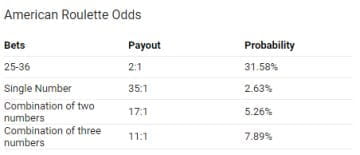



Odds Probability The Difference Explained With Examples
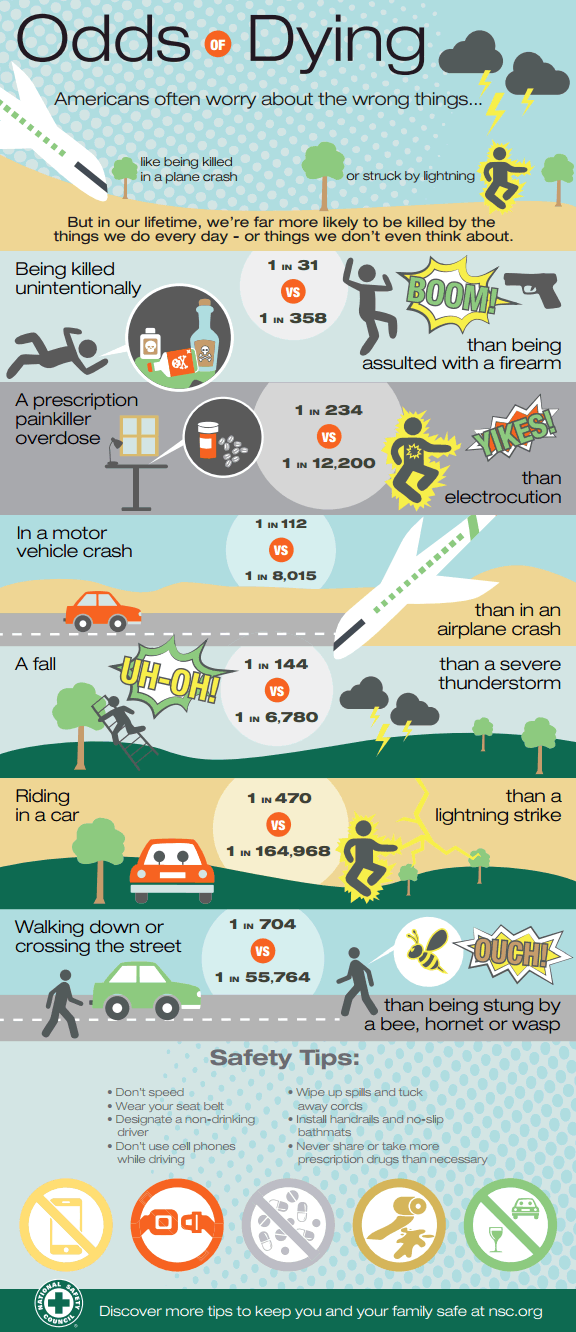



Worried About Dying From Surgery Hurricane Plane Crash Check Out The Odds
Odds, are given as (chances for success) (chances against success) or vice versa If odds are stated as an A to B chance of winning then the probability of winning is given as P W = A / (A B) while the probability of losing is given as P L = B / (A B)The odds of not rolling a 5 or 6 is the inverse 42 This is because there are 4 events that produce the specified outcome of "not rolling a 5 or 6" (rolling a 1,2,3, or 4) and two that do not (rolling a 5 or 6) The probability of an event is different, but related, and can be Chance or Likelihood Chance, a synonym of probability, is usually expressed as a percentage (eg 75%) Chance is used primarily in weather predication, and typically indicates the likelihood of a given weather event occurring in a specific area over a certain period of time Odds




Probability Odds Odds Ratio Youtube




The Bounded Rationality Of Probability Distortion Pnas
The differences between odds and probability are discussed in the points given below The term 'odds' is used to describe that if there are any chances of the occurrence of an event or not As against, While odds are expressed in the ratio, the probability is either written in percentage form or
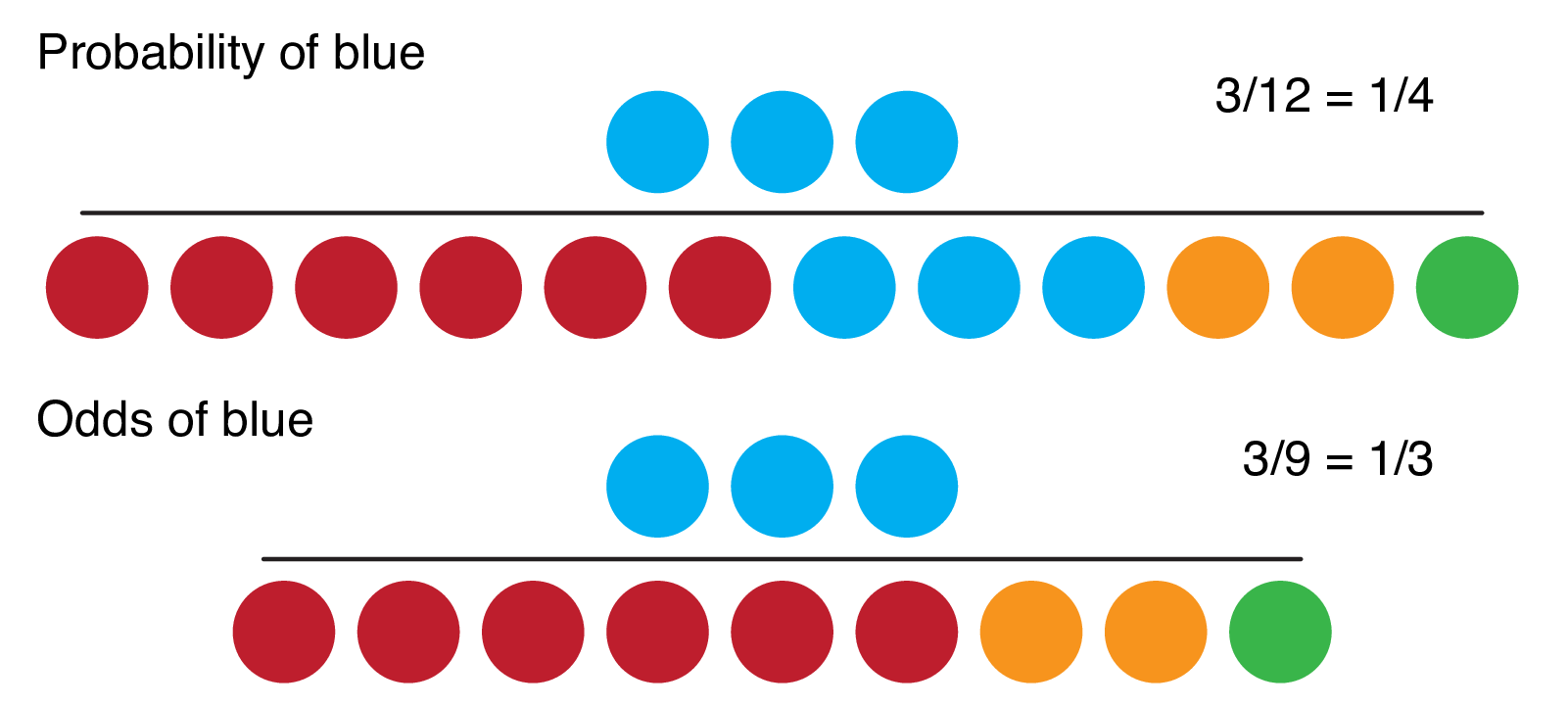



9 2 Binary Logistic Regression R For Health Data Science




Odds Vs Probability What S The Difference Ask Difference




Binary Logistic Regression With Odds Ratios Calculated For The Download Table




Odds Ratios Versus Relative Risk




Lecture 38 Monday April 16 12




Are The Odds Ever In Your Favor Car Crashes Versus Other Fatalities News Cars Com




10 1 10 2 Probability Permutations Warm Up Ppt Download
:max_bytes(150000):strip_icc()/dotdash_Final_The_Math_Behind_Betting_Odds_and_Gambling_Nov_2020-01-735accb453c8424b9e063c2c14e4edf4.jpg)



The Math Behind Betting Odds Gambling




The Difference Between Relative Risk And Odds Ratios The Analysis Factor




Biostatistics Weeks 10 11 Flashcards Quizlet




Estimates Of Odds Ratios Of Daily Probability Of Diarrhea In The Download Scientific Diagram




Probability And Odds Youtube




What Are The Odds The Annals Of Thoracic Surgery




Bayes Rule Odds Form Intro Math 1 Arbital
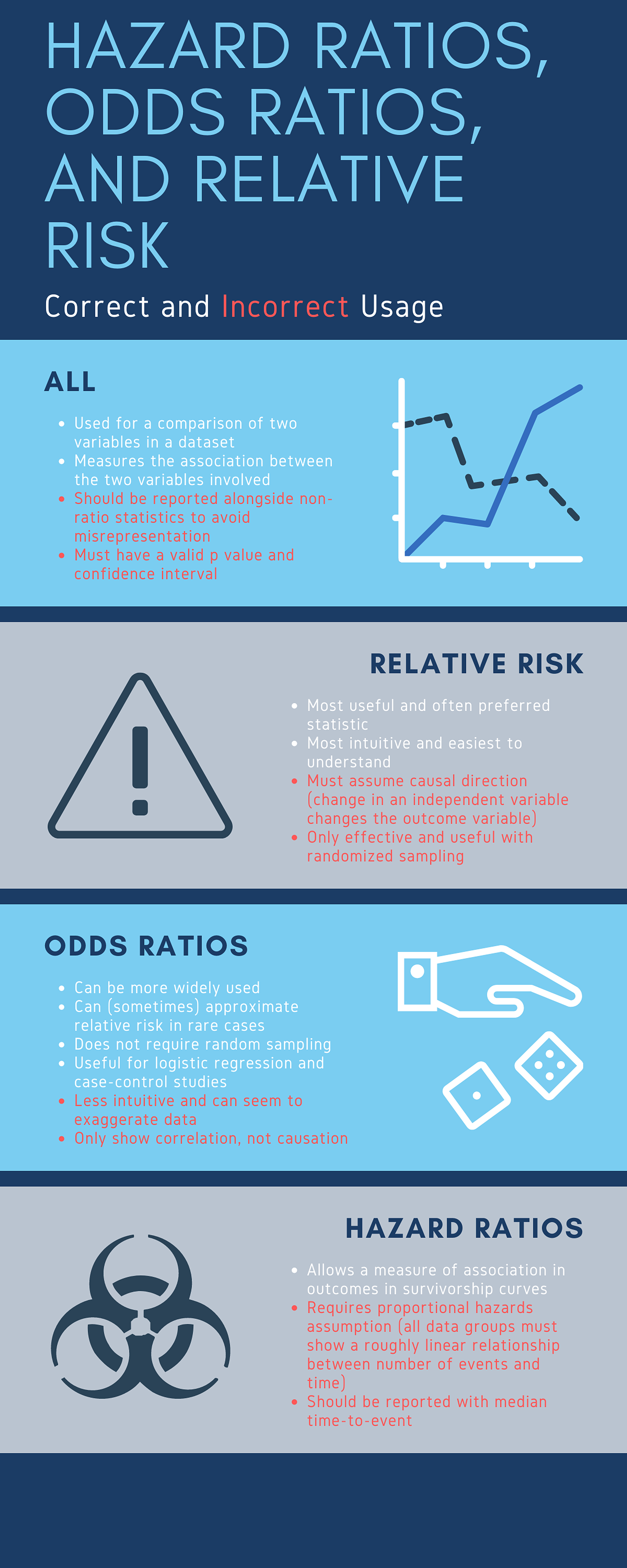



Cureus What S The Risk Differentiating Risk Ratios Odds Ratios And Hazard Ratios




Bayesian Analysis A Brief Introduction Robert West University




True Odds Calculator Find Probabilities Fair Odds Margin




What Is The Difference Between Odds And Probability Statistics Youtube



1




Odds Ratios And Risk Ratios Youtube




How Sports Betting Odds Work How To Read Odds Explanation Video




How To Read And Calculate Sports Odds Everything You Need To Know Betting 101




Odds Ratio Wikipedia
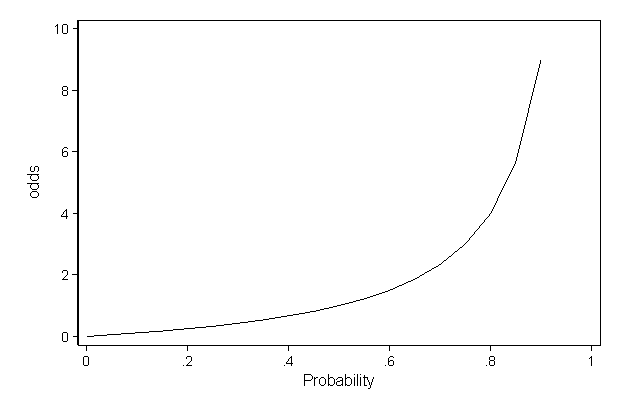



Faq How Do I Interpret Odds Ratios In Logistic Regression



Odds Likelihood Ratios Guide To Diagnostic Tests




How To Calculate Odds 11 Steps With Pictures Wikihow
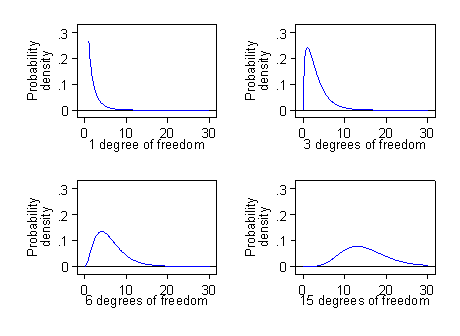



Proportions Chi Squared Tests And Odds Ratios




Odds Probability And The Lottery Lotterycodex




A Ratio Is A Fraction Odds Are A Type Of Ratio Fraction S Ratios 1 4 Odds 1 3 Ppt Download




Relation Between Probability And Odds At Different Values Of Probability Download Scientific Diagram




Math 30 2 Probability Odds Acceptable Standards 50 79 The Student Can Express Odds For Or Odds Against As A Probability Determine The Probability Ppt Download



Odds
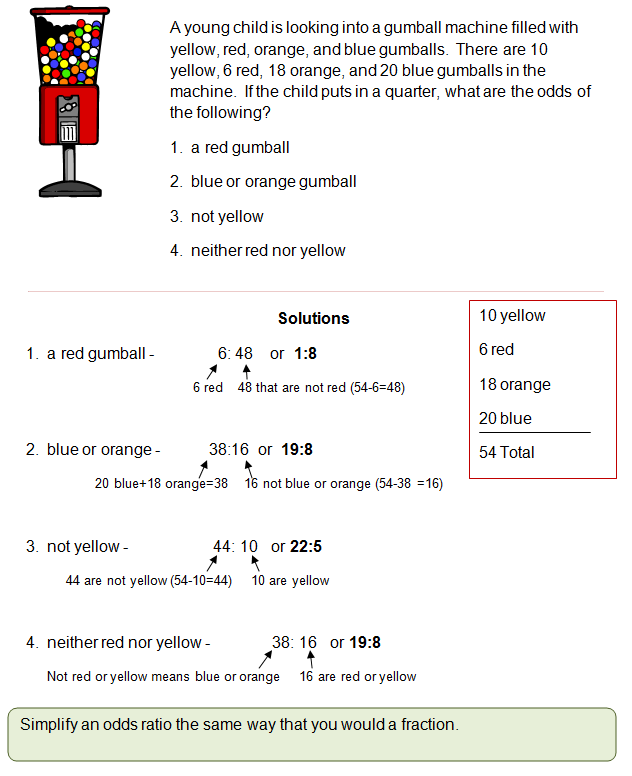



Odds And Probability



Odds
/CompoundProbability2-9402bf638f6e4da9882dbdbd23dbd918.png)



Compound Probability Definition




What Is An Odds Ratio And How Do I Interpret It Critical Appraisal




Estimates Of Odds Ratios Of Daily Probability Of Diarrhea In The Download Scientific Diagram




Comparing Probability Odds For And Odds Against Youtube




Converting Between Probability And Odds Mathwoes Youtube




Odds Ratio Wikipedia




Relative Risks And Odds Ratios What S The Difference Mdedge Family Medicine




What And Why Of Log Odds What Are Log Odds And Why Are They By Piyush Agarwal Towards Data Science
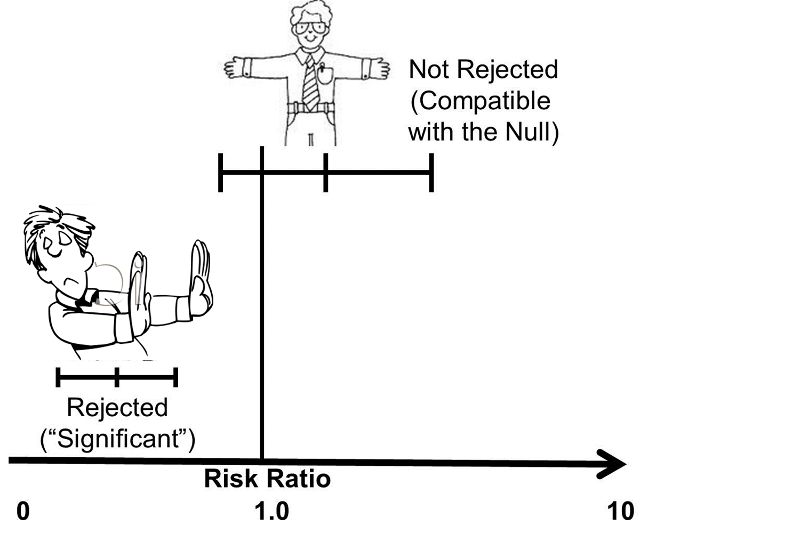



Confidence Intervals And P Values
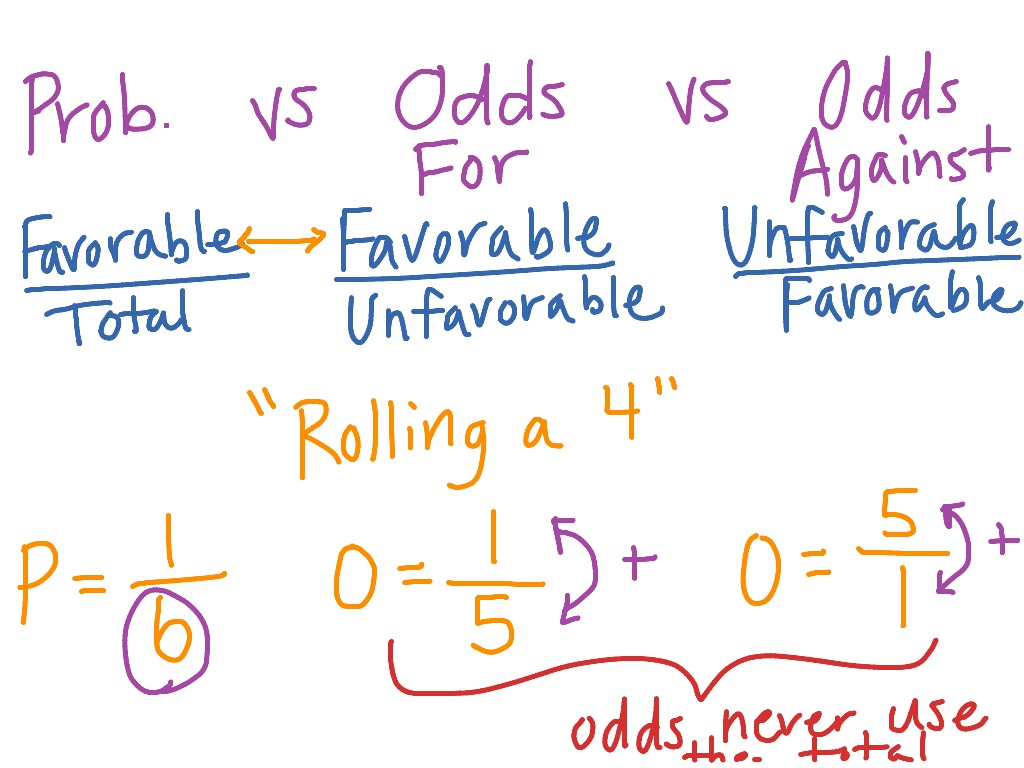



Odds Versus Probability Math Showme




E Birbeck 7 04 Simple Probability Definition Probability The Chance Some Event Will Happen It Is The Ratio Of The Number Of Ways Ppt Download




Simple Probability Definition Probability The Chance Some Event




Solved 9 6 Odds To Probabilities 1 If The Odds Of An Chegg Com




Solved Prove The Posterior Odds Updating Formula For Chegg Com




Probability Vs Odds In Favour Or Against An Event Examples Youtube




Odds Introduction Arbital
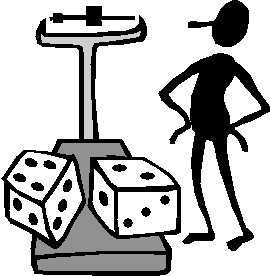



The Difference Between Probability And Odds




Definition And Calculation Of Odds Ratio Relative Risk Stomp On Step1




Probability Vs Odds What S The Difference Learn It And By Z Ai Towards Data Science
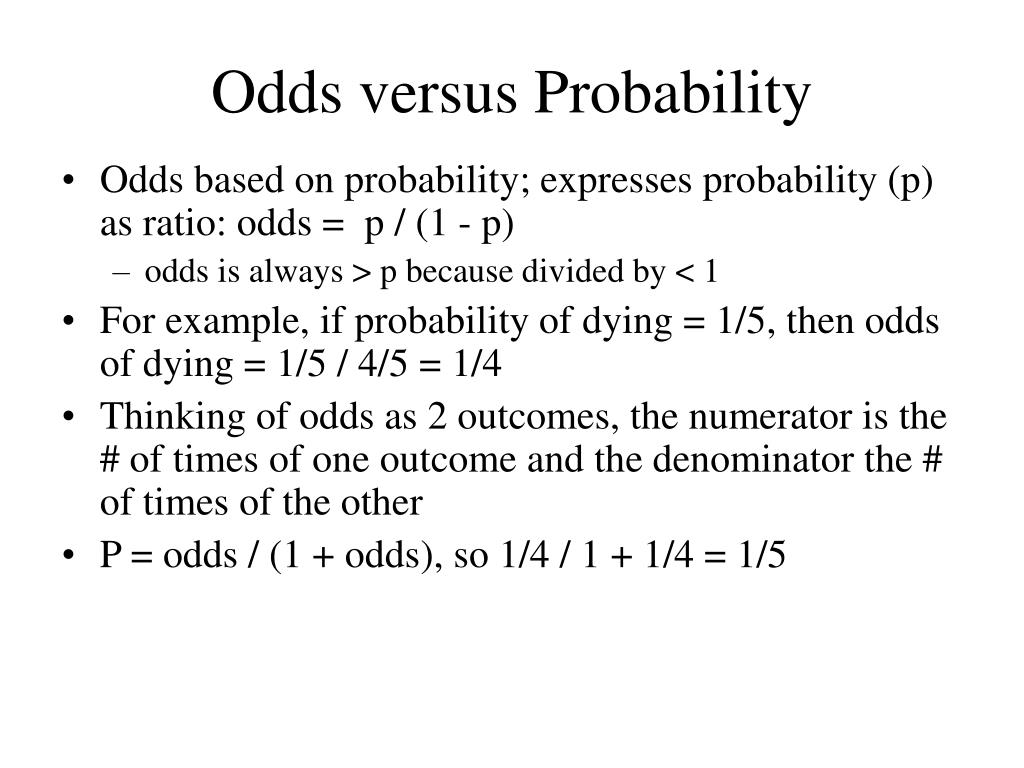



Ppt Main Points To Be Covered Powerpoint Presentation Free Download Id
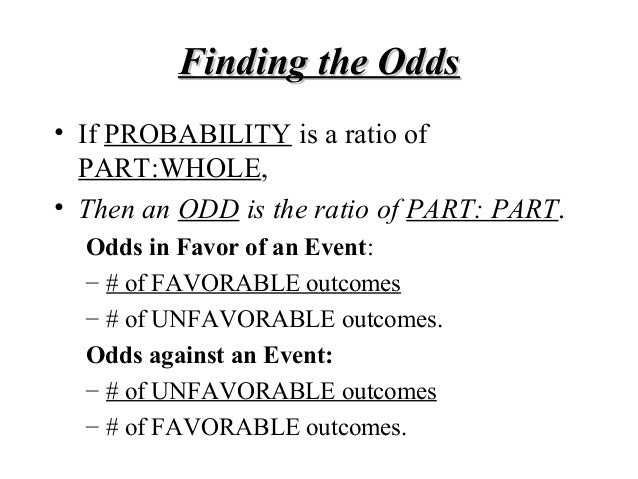



5 6 Probability And Odds Lesson




How To Calculate Odds 11 Steps With Pictures Wikihow



Odds Vs Probability Vs Chance Data Science Central




Cureus What S The Risk Differentiating Risk Ratios Odds Ratios And Hazard Ratios




Probability Vs Odds Youtube




The Odds Ratio Calculation Usage And Interpretation Biochemia Medica
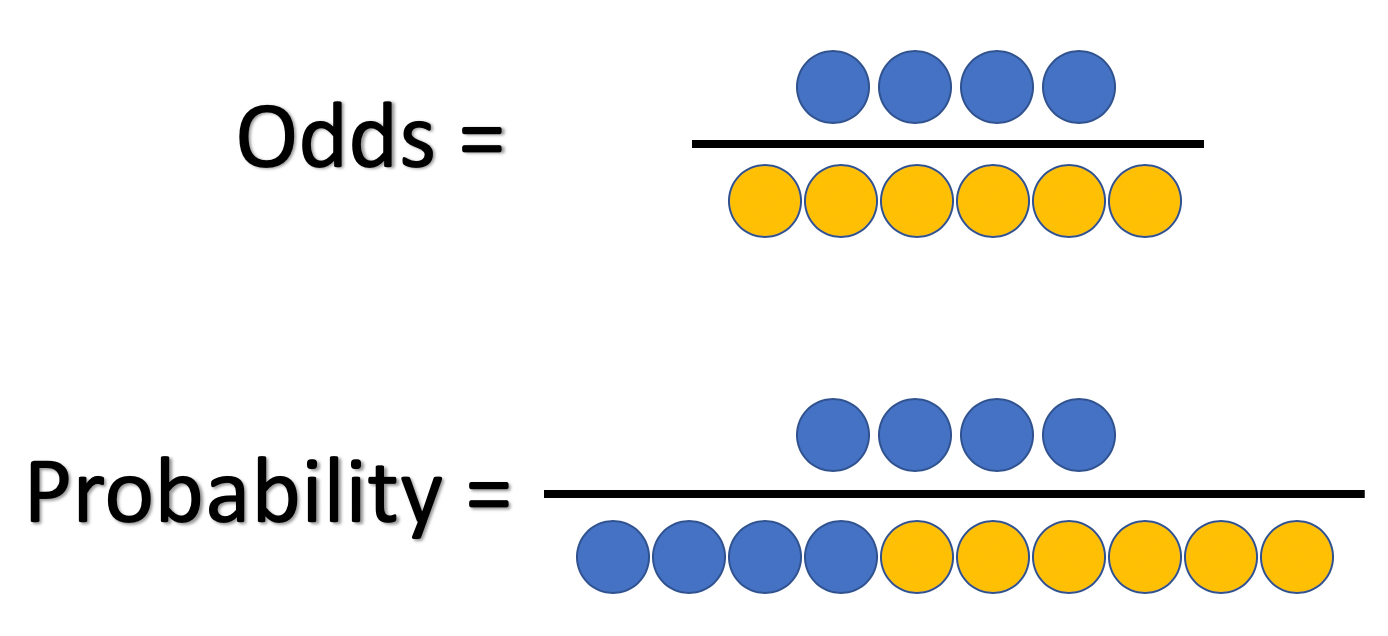



What And Why Of Log Odds What Are Log Odds And Why Are They By Piyush Agarwal Towards Data Science




Risk Versus Chance What Are The Odds Health And Communications Probability Communications Odds
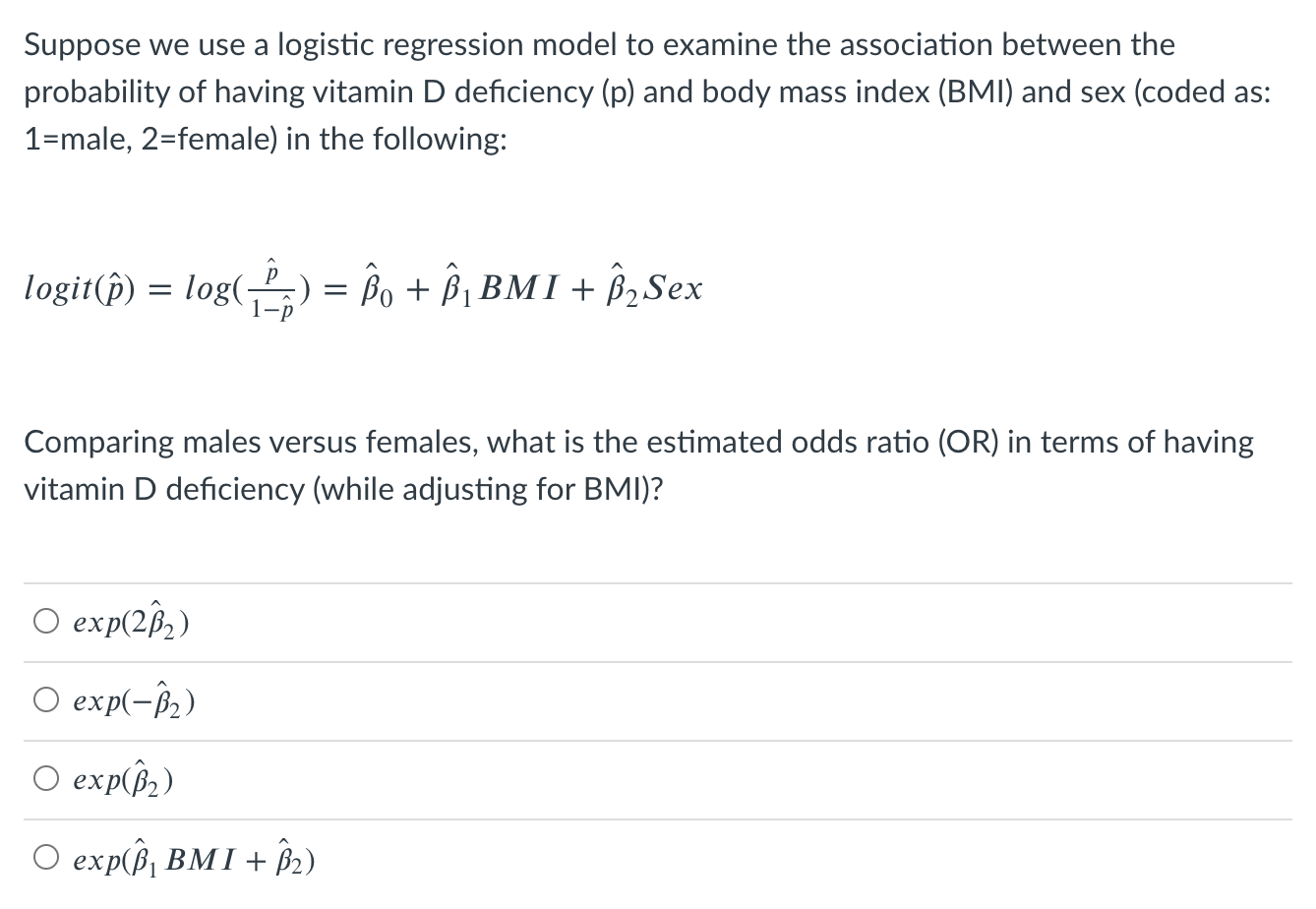



Suppose We Use A Logistic Regression Model To Examine Chegg Com




Statistics 12 Probability Vs Odds Stats Seandolinar Com




How To Read And Calculate Sports Odds Everything You Need To Know Betting 101
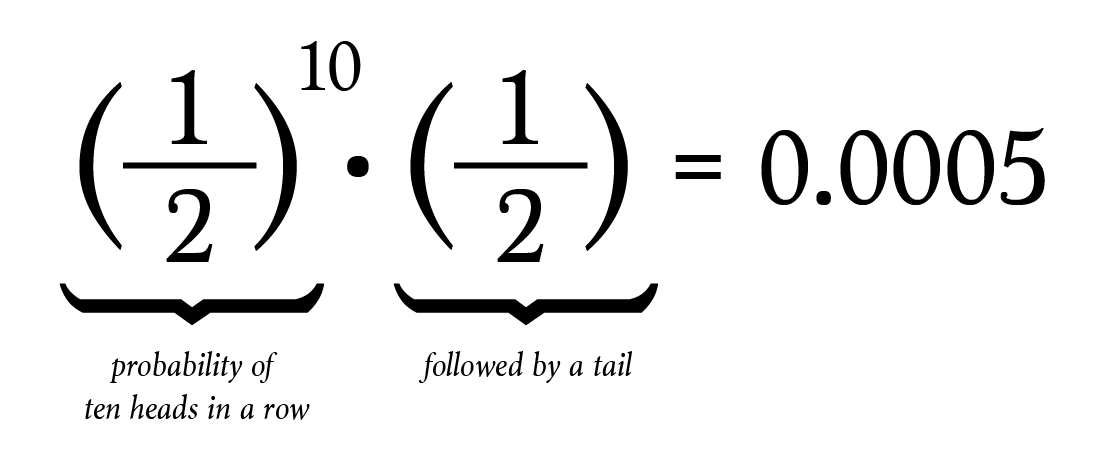



That Common Misconception About Probability By Brett Berry Math Hacks Medium




Probability Vs Odds In Favour Or Against An Event Examples Youtube




Probability Probability Vs Odds Lesson Math Statistics Showme
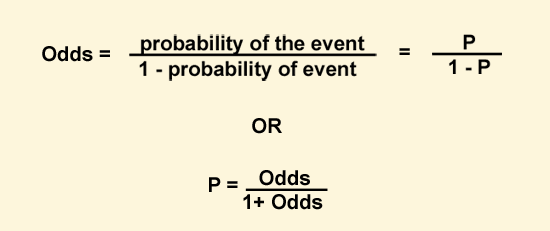



Nhanes Tutorials Module 10 Logistic Regression



Odds Likelihood Ratios Guide To Diagnostic Tests
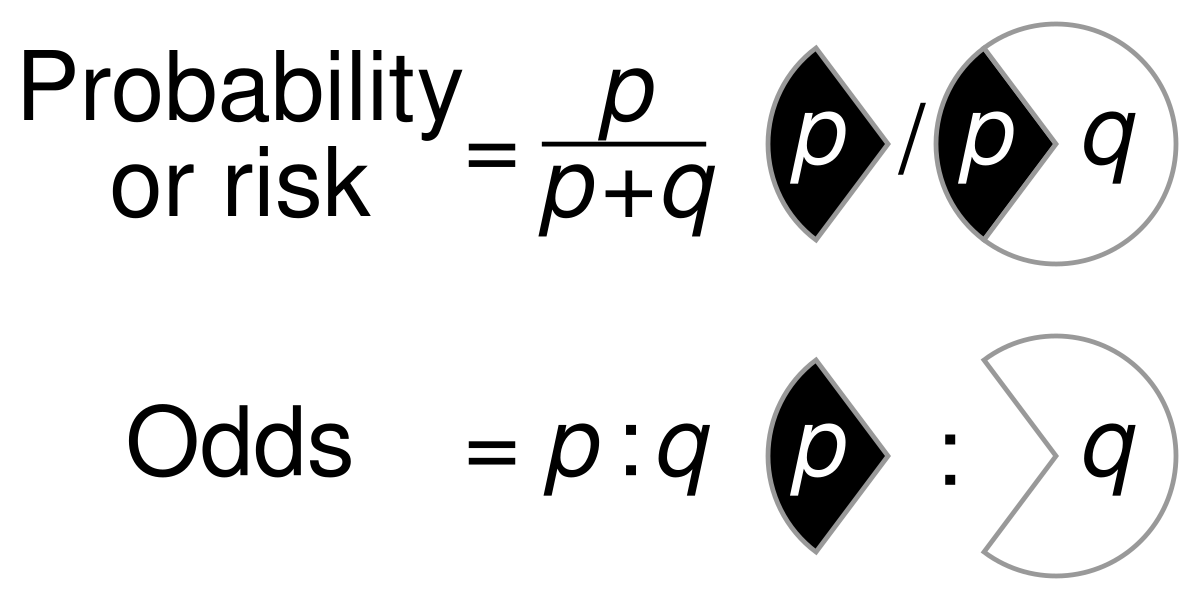



File Probability Vs Odds Svg Wikimedia Commons




Probability Vs Odds What S The Difference Learn It And By Z Ai Towards Data Science




The Fed A New Way To Visualize The Evolution Of Monetary Policy Expectations




Log Odds Definition And Worked Statistics Problems




Betting Guide Odds Versus Probability Odds Margin Calculator




Odds Ratio The Odds Ratio Is Used To Find The By Analyttica Datalab Medium



Definition And Calculation Of Odds Ratio Relative Risk Stomp On Step1




Faq How Do I Interpret Odds Ratios In Logistic Regression




The Monty Hall Problem Video Probability Khan Academy




Observed Versus Model Based Left Precipitation Probabilities Right Download Scientific Diagram


